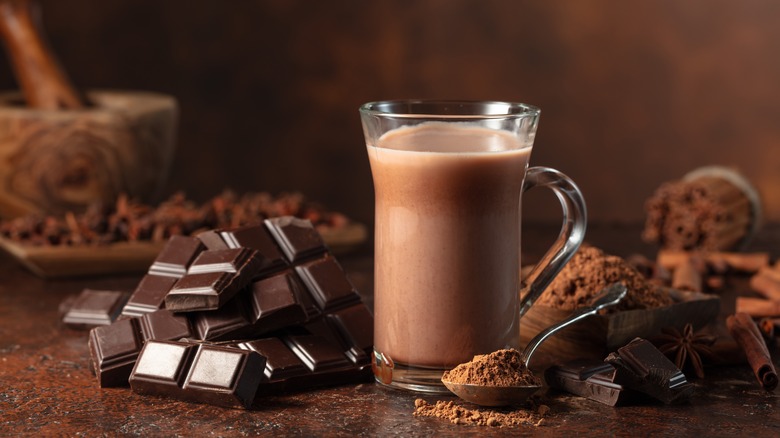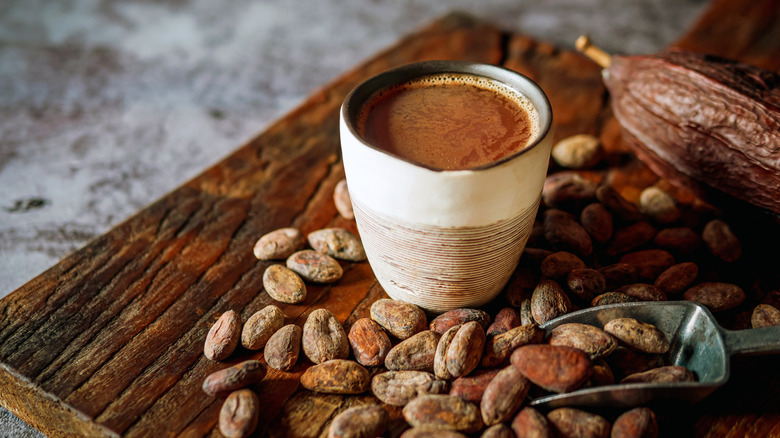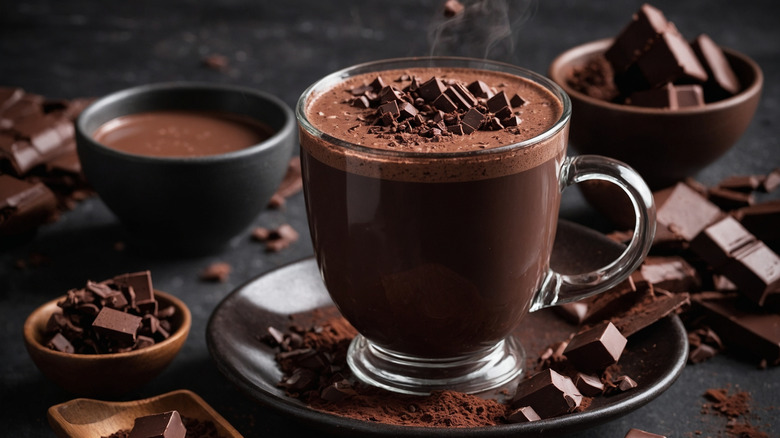Here's The Actual Difference Between Hot Chocolate And Hot Cocoa
The terms hot chocolate and hot cocoa are quite frequently used as synonyms, but these two drinks have differences in their ingredients, how they are made, and their taste. Both provide a chocolatey experience, but knowing what makes each one different can help you appreciate these drinks even more. The main difference is that hot cocoa is made from cocoa powder while hot chocolate is crafted from actual chocolate, usually in the form of bars or chips. Most pre-packaged mixes labeled as hot chocolate are, in fact, hot cocoa. This key difference leads to variations in taste, texture, and the overall beverage.
You'll likely find that hot cocoa has a grittier, grainier feeling, and it might also clump while you're mixing, as it comes from a light powder that is harder to dissolve. Hot chocolate, on the other hand, comes from melted chocolate and has a smooth, thicker consistency that will usually not clump due to the density (and fat) of the chocolate. To avoid clumps in cocoa, try making a paste (with a small amount of hot milk) before adding it to the rest of your pot or mug. It will be easier to incorporate smoothly.
What is hot cocoa?
Hot cocoa starts with cocoa powder, which comes from cocoa beans that are roasted, stripped of their cocoa butter (fat from the cocoa beans), and ground into a fine powder. To make hot cocoa, this powder is mixed with sugar, and hot water, cream, or milk. The amount of sugar can be adjusted for individual taste preferences, and some recipes include other flavors like vanilla extract or spices. Cocoa powder is naturally unsweetened, making some type of sweetener a necessary part of any hot cocoa recipe.
There are two primary types of cocoa powder, which are natural and Dutch-processed powders. Natural cocoa powder is more acidic due to cocoa beans having a naturally higher acidity level, which creates a sharper, more bitter flavor. Dutch-processed cocoa powder is treated with an alkali – which assists in neutralizing the cocoa beans' high acidity level — to reduce the bitterness, giving it a smoother, more mellow taste. The kind of cocoa powder used can significantly impact the final taste of your hot cocoa. Natural cocoa will be sharper, having more citrus notes while the Dutch kind may have a bit of earthiness.
What Is hot chocolate?
Hot chocolate is made with actual chocolate, which can be milk, dark, or white chocolate – or any combination therein. To make hot chocolate, the chocolate is melted and then mixed with some sort of hot liquid, usually milk or cream. Unsurprisingly, the type of chocolate used has a big impact on the flavor and richness of the drink.
Milk chocolate makes for a sweeter, milder sip — whereas dark chocolate gives a stronger, slightly bitter taste. White chocolate, which has no cocoa solids, provides a different, smooth yet rich beverage. Some recipes mix different types of chocolate to get a more balanced flavor.
In some parts of Europe, hot chocolate is different from what you might expect. Spanish hot chocolate, or dipping chocolate, is very thick, almost like pudding, and is often made with dark chocolate, milk, cornstarch, and sugar. There is also a version of hot chocolate inspired by Mexico that you can order from Starbucks, which features dark chocolate, the milk of your choice, and has notes of cinnamon. The actual Mexican version of hot chocolate, which is called champurrado, is often paired with churros to add a crunch and an additional sweet flavor.



